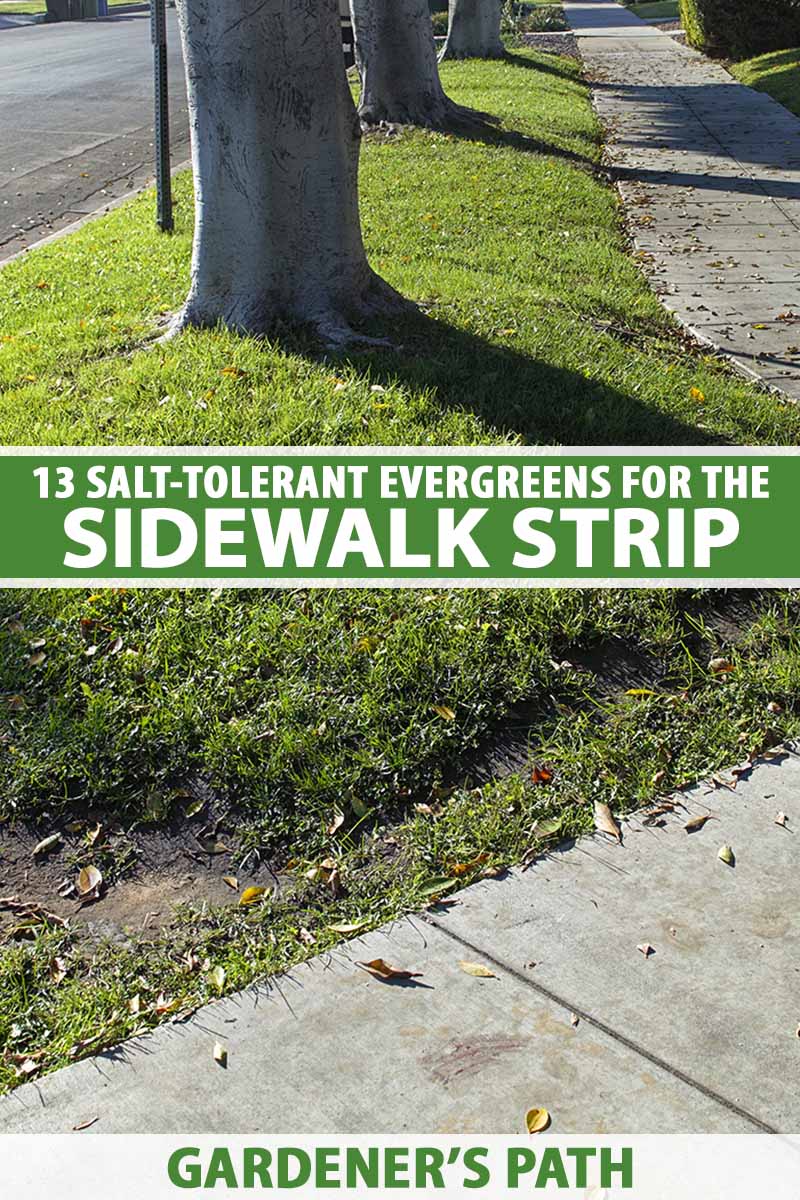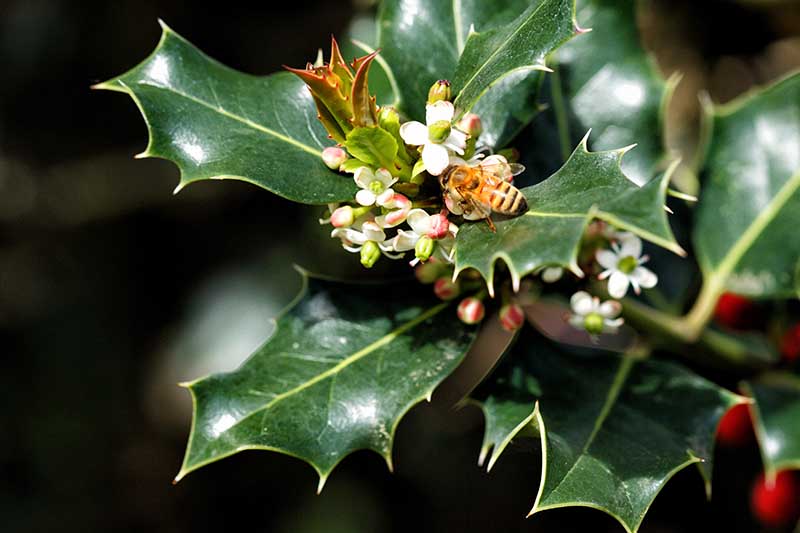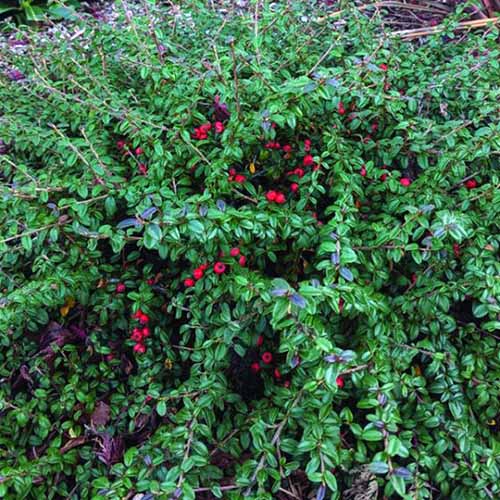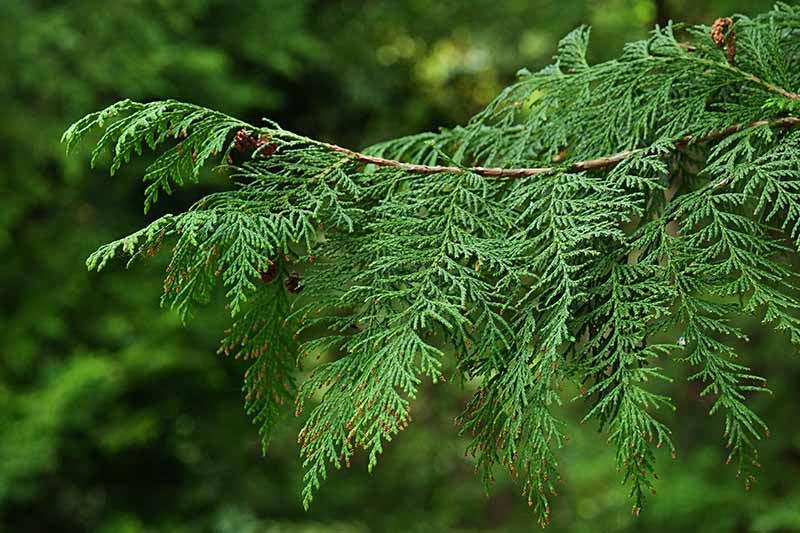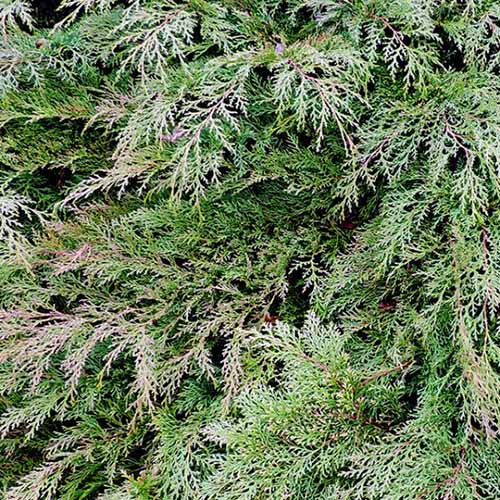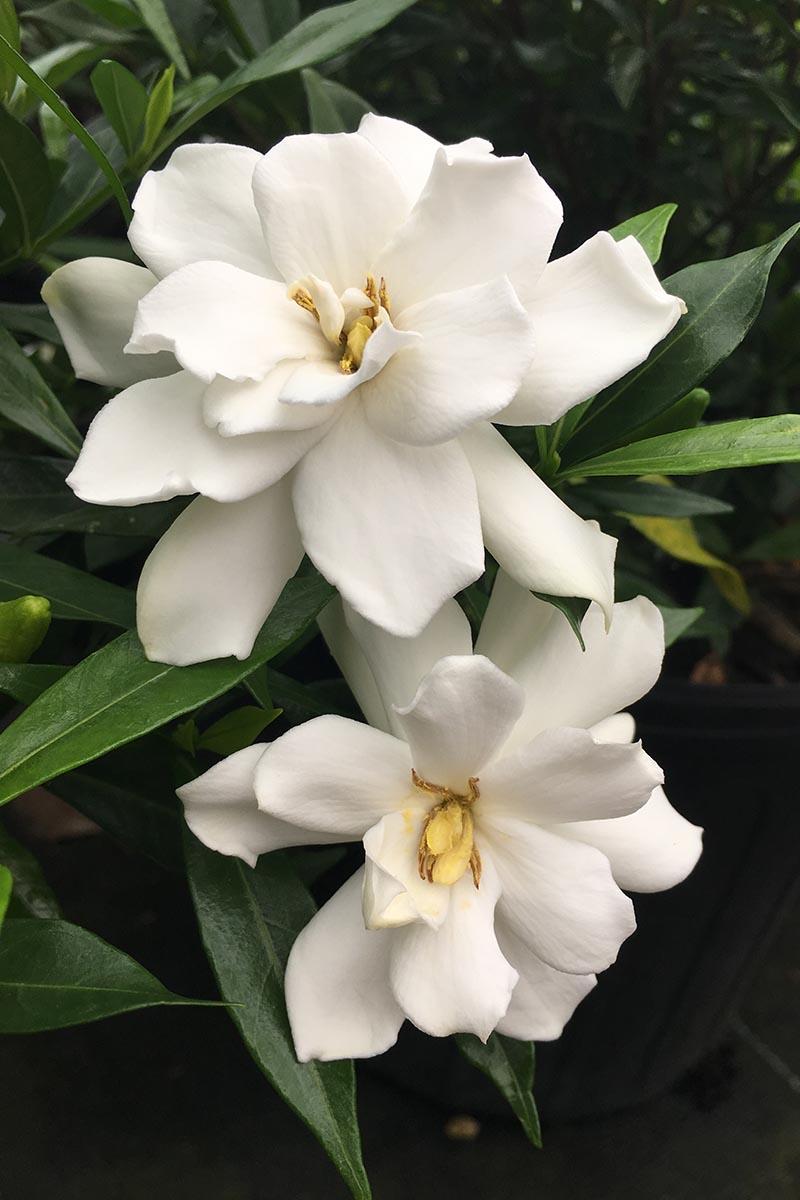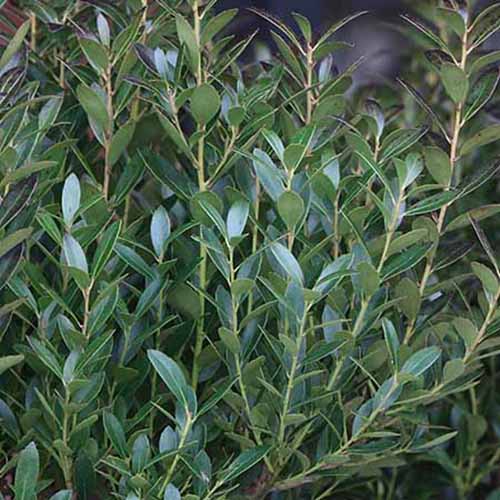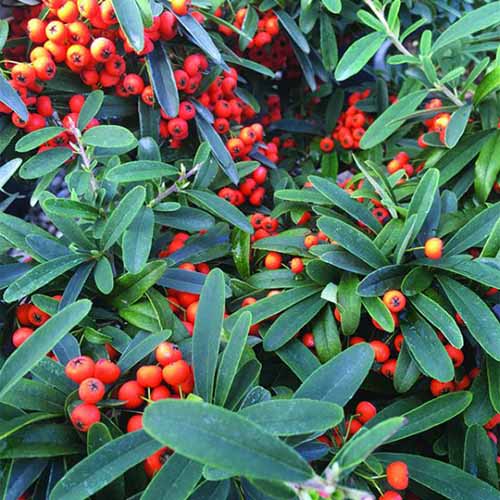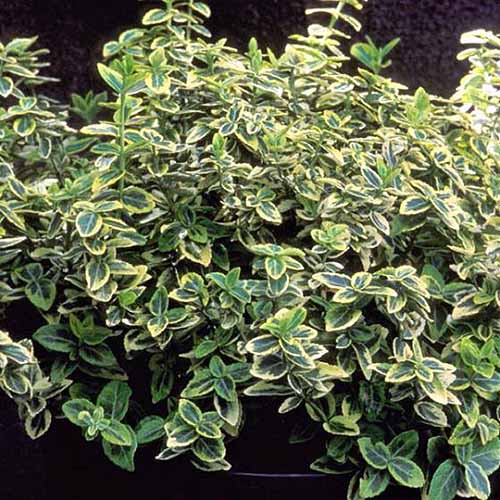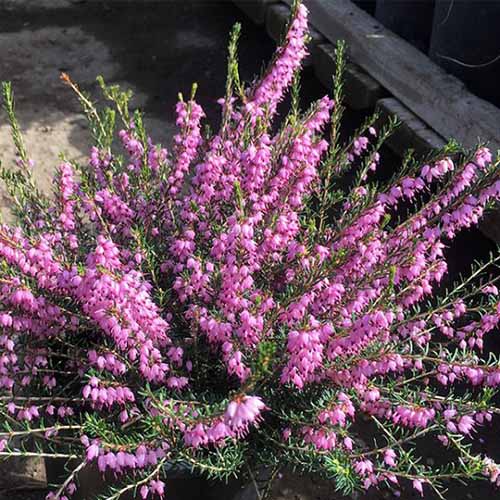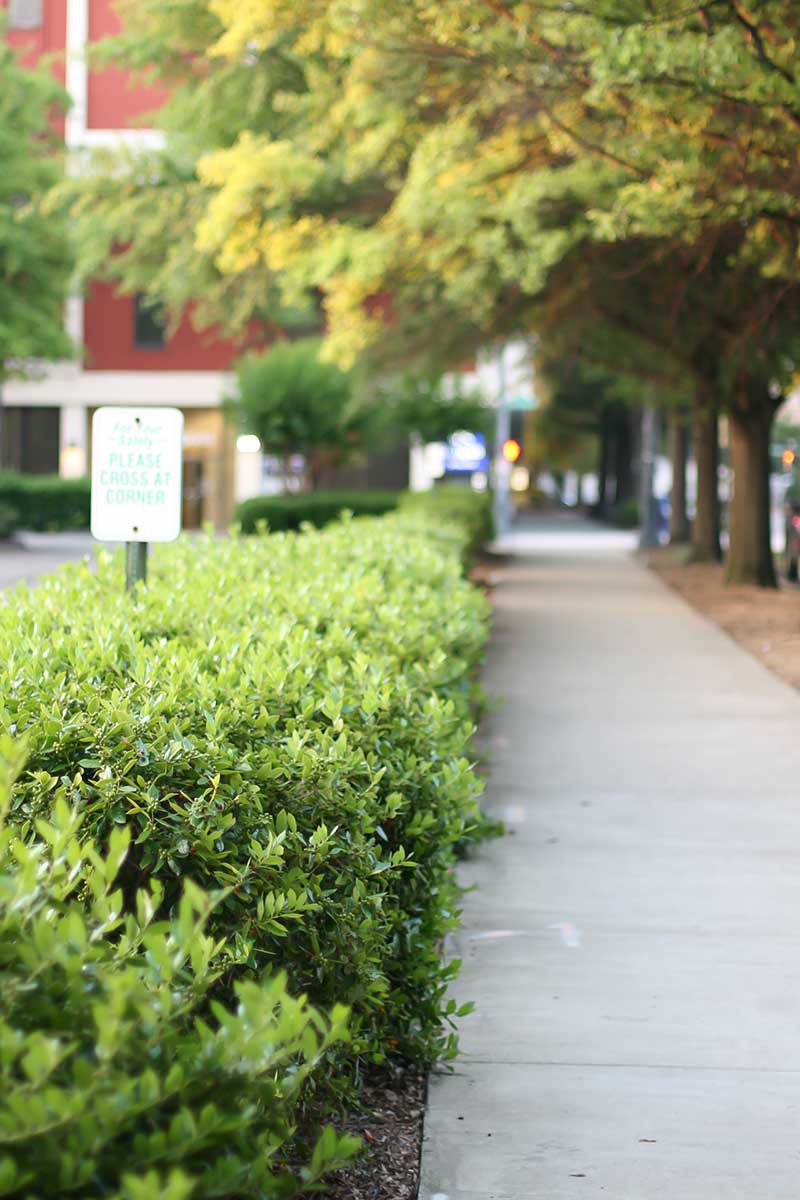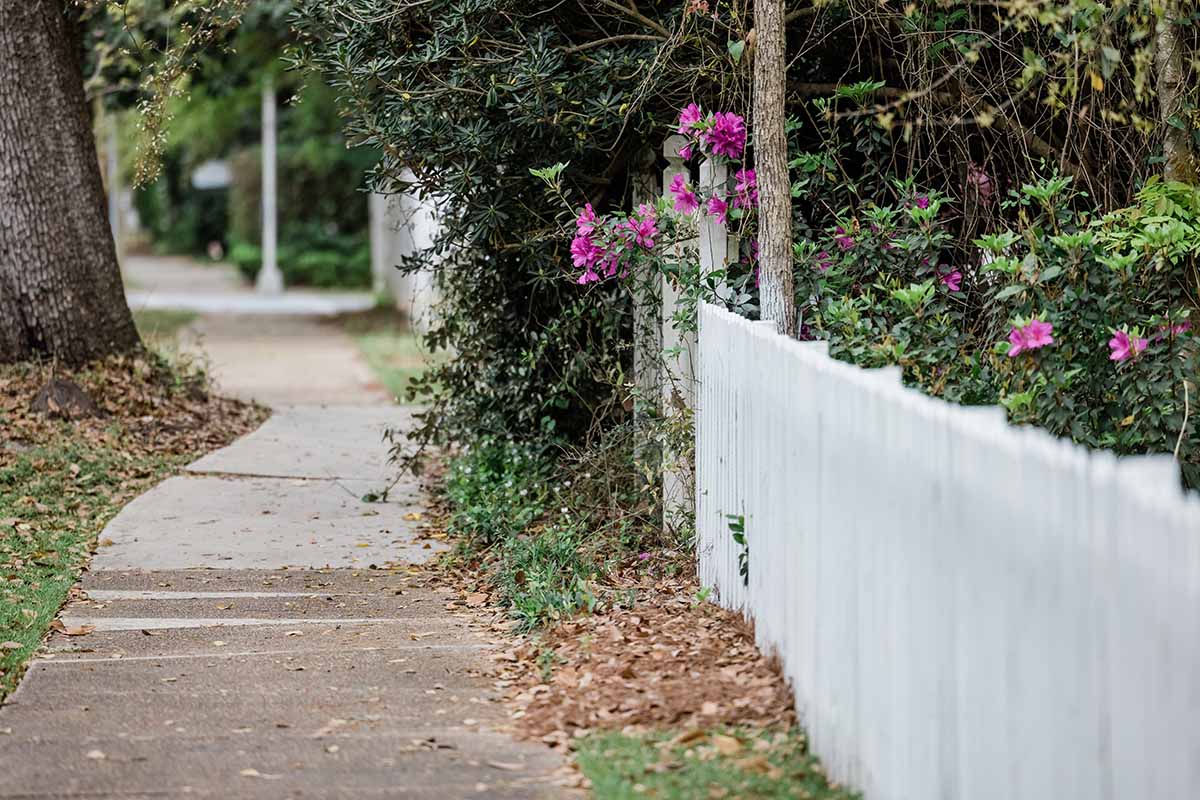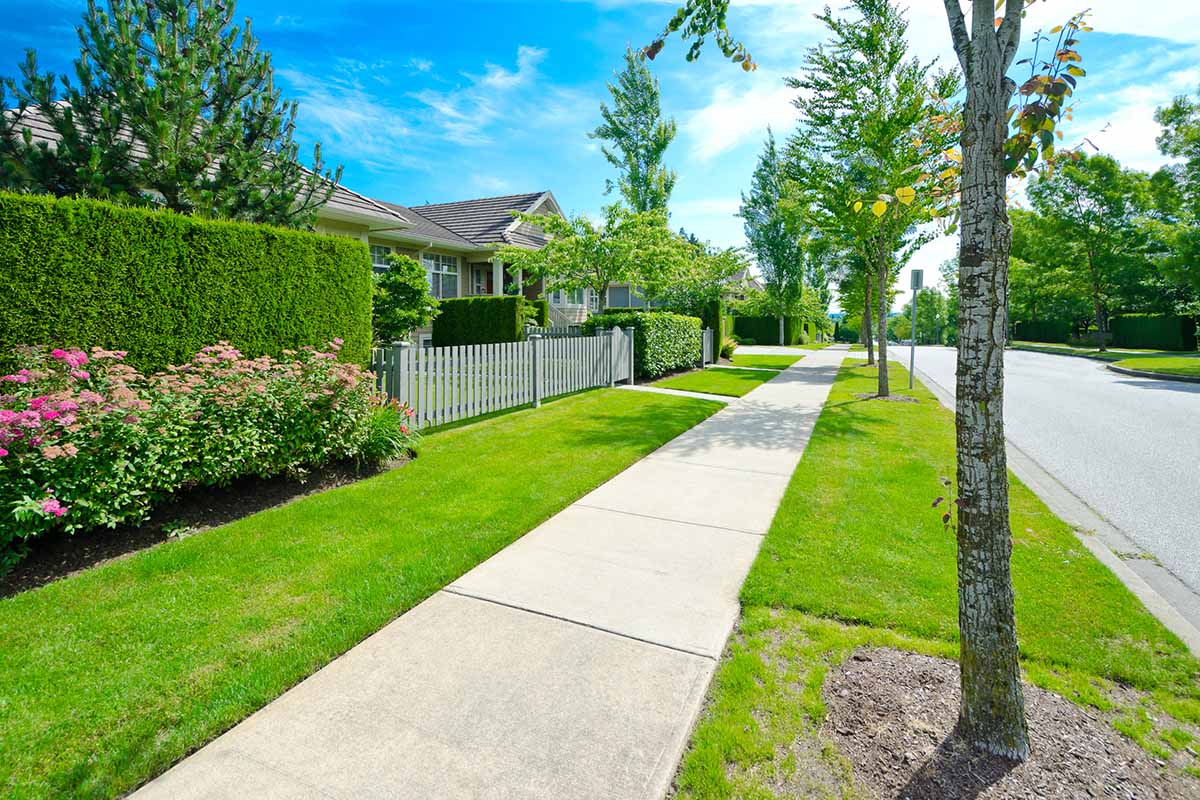When I lived in Oklahoma for two years, wintertime was difficult. There were few evergreen trees or shrubs in my neighborhood, and with no snow, just about everything that was once thriving and green turned a depressing shade of gray for months on end. I’d come home from work and stare at the hedge of boxwoods in front of my porch, just to see something green. But you know what? It always made me feel just a little bit better. If you’re looking for the best evergreen shrubs to provide year-round beauty in that strip between the sidewalk and the street, you’ve come to the right place. In this roundup there’s a shrub for everyone, even if you live in frosty Zone 2. We link to vendors to help you find relevant products. If you buy from one of our links, we may earn a commission. Plants in coastal areas can also suffer from salt spray, or saline soil. And if you plant evergreens in the berm outside your house that can’t tolerate salt, they can suffer from discolored foliage, leaf burn, and stunted growth, or they may even die. So what are the best salt-tolerant evergreen shrubs to shield your home from the road while providing year-round interest and a more pleasing view? Here’s our selection of 13 of the best evergreen shrubs to plant between the sidewalk and the street.
1. American Holly
If you want to grow a moderately salt-tolerant shrub that also provides you with remarkable winter scenery, try growing American holly, Ilex opaca. This shrub likes moist, loamy, well-draining soil and prefers full sun, although it can tolerate some shade. This evergreen shows off its glossy new growth in the spring, and the spiny leaves stay on the shrubs all year long. If you plant both males and females that bloom at the same time, the females will develop red, orange, or yellow berries, depending on the cultivar. American holly is native to the eastern half of the United States, and is suited to Zones 5 through 9. This shrub grows in a pyramidal shape, and it can reach 35 to 50 feet tall with a spread of 15 to 20 feet! But if you don’t want such a tall plant, you can keep your shrub pruned to whatever height you desire.
2. Bearberry
Also called kinnikinnick (Algonquin for “smoking mixture”) by indigenous peoples, bearberry (Arctostaphylos uva-ursi) is the ideal salt-tolerant evergreen shrub for those of us who live in frigid growing zones. It’s hardy in Zones 2 to 6. This wide, relatively short shrub makes a perfect addition to that strip between the sidewalk and the street. ‘Greenleaf’ American Holly For something a little taller – but not too tall – try ‘Greenleaf,’ a male cultivar. This pleasingly pyramidal shrub grows 10 to 15 feet wide and tops out at 10 to 15 feet in height. Live four- to five-foot ‘Greenleaf’ plants are available for purchase from FastGrowingTrees.com. You can learn more about American holly in our growing guide. Uva-ursi means “grape of the bear” in Latin. And yes, bears do like to eat the small red berries that these shrubs produce in the summer. I regularly see this low-growing shrub in the Alaskan wilderness around my home. The light pink, bell-shaped flowers are a sweet sign of spring, and the red berries that come later provide a pop of color that contrasts nicely with the small, rounded, bright green leaves. This woody evergreen grows six to 12 inches tall and spreads three to six feet. It blooms between April and May, enjoys full sun or part shade, and prefers soil that dries out completely between watering. Bearberry can tolerate all sorts of soil, as long as it’s slightly acidic.
3. Cotoneaster
Cotoneasters are members of the rose family, and native to north Africa, parts of Asia, and Europe. While not all plants in the Cotoneaster genus are evergreen, ‘Emerald Beauty’ sure is. It is an ideal salt-tolerant ground cover for your street strip, and you’ll be able to enjoy the vibrant leaves all year long – though you may not be able to see them for part of the winter if you experience heavy snowfall. While this species can be hard to find in nurseries and it doesn’t transplant well from the wild, it’s easy to propagate from cuttings. If you know someone with an existing plant that you can take a few snips from, give them a call! Bearberry ‘Emerald Carpet’ Bearberry If you live in California or any warmer zone with coastal ocean salt, try this warm-weather kinnikinnick from FastGrowingTrees.com. Cultivated specifically for California, ‘Emerald Carpet’ grows best in Zones 8 through 11. With satiny, rounded leaves, small white flowers in the spring, and bright orange-red berries in the summer, there’s always something to admire when you plant ‘Emerald Beauty’ shrubs.
Additional Considerations
After you’ve sketched out a plan and made your selections, but before you purchase your shrubs and break ground, there are a few important considerations to keep in mind. Cotoneaster thrives in rich, well-draining soil. Keep in mind that this shrub loves the sun, and needs full sunlight in order to thrive. ‘Emerald Beauty’ Cotoneaster Bred by horticulturists at Oregon State University for extra resistance to fire blight, it’s a tough plant that won’t succumb easily to this disease. You can find plants in two-gallon containers available at Nature Hills Nursery. Learn how to grow cotoneaster in our guide.
4. English Yew
For a delightful evergreen shrub that you may have seen gracing the property of an old churchyard, try growing English yew, Taxus baccata. This long-living plant has dark green needles that’ll brighten your spirit on a winter day. With moderate salt tolerance, you can rest assured that sidewalk salt won’t harm this shrub. Keep in mind that any English yew may develop berries if there are both female and male plants around, and that these berries are toxic. If you have pets or young children, they may not be a safe choice for your landscape. English yew is suited to Zones 5 through 7. This plant can live 150 years or longer, making it the perfect long-term investment. It’s also an easy-care shrub in that it can do well in conditions ranging from full sun to full shade. As long as the soil is well-draining, loamy, and evenly moist, your yew will be happy. Left untrimmed, it grows 20 to 25 feet tall and spreads 15 to 20 feet. Thankfully, the plant grows slowly, giving you plenty of time to keep it pruned to whatever shape or size you desire. For even more control over the height of this salt-tolerant shrub, try planting a spreading variety like ‘Repandens.’ ‘Repandens’ English Yew This cultivar grows just two to four feet tall but slowly spreads six to 12 feet over time, making it an ideal specimen for a hedge or border. You can find live spreading yew plants in three-gallon containers from Nature Hills Nursery.
5. False Cypress
This hardy, moderately salt-tolerant shrub is perfect in so many ways. Several species in the Chamaecyparis genus are considered false cypresses, including the popular Chamaecyparis lawsoniana, C. obtusa, C. pisifera, and C. thyoides. The evergreen false cypress is native to parts of Asia and North America. Most varieties are suited to Zones 4 through 8, making them excellent choices for many snowy locales. Height and spread vary widely, but most false cypresses have feathery leaves and a beautiful green-gold color that develops in ideal full-sun conditions. False cypress prefers moist, well-draining soil but it isn’t picky otherwise. A cultivar that’s ideal for many locations is ‘Koster’s,’ a Hinoki false cypress (C. obtusa) which hails from Japan. ‘Koster’s’ False Cypress ‘Koster’s’ grows four to five feet tall and spreads four to five feet wide, so if you plant a line of these tidy evergreen shrubs, you’ll have plenty of greenery to look at without overwhelming your growing area. You can purchase live plants in one-gallon containers from Nature Hills Nursery.
6. Gardenia
If the cold weather and reduced sunlight in winter make you feel tired, why not plant a member of the coffee family in your front yard? Gazing out at your gardenias in the winter might just give you the jolt of energy you need. And though these plants don’t produce caffeine, the flowers are actually edible. Plants in the Gardenia genus originate from some of the warmest places on the globe: the tropical and subtropical areas of Australia, Asia, Africa, and the Pacific Islands. This heat-loving plant has just enough salt tolerance to thrive in homes near the coast. It prefers consistently moist, rich, well-draining soil and full sun, but it appreciates light afternoon shade in hotter climates. And with its dark-hued evergreen leaves and waxy, sweet-scented white flowers, it makes a stunning addition to any yard. Gardenias are suited to Zones 8 through 11, although some can tolerate Zone 7 winters. If you live in Zone 7 and want a salt-tolerant shrub to plant in that strip between the sidewalk and the street, try growing ‘Frost Proof,’ one of the most – if not the most – cold-tolerant gardenias around. ‘Frost Proof’ Gardenia This variety grows four to five feet tall and spreads just three to four feet. The glossy leaves will keep you company all winter – long after the blooms fade. You can purchase live plants in quart-sized, one-gallon, or three-gallon containers from Nature Hills Nursery. Learn how to grow and care for gardenia in our guide.
7. Inkberry Holly
For a salt-tolerant evergreen with a touch of class, try inkberry holly, Ilex glabra. Native to North America all the way from Canada down to Texas, inkberry holly thrives in Zones 3 to 9. This shrub loves acidic, slightly moist soil, and has a full, rounded growth habit. It adapts well to pruning and makes a fantastic low hedge at the edge of the yard or sidewalk, where it will thrive in part shade or full sun. ‘Shamrock,’ one of the most popular cultivars, grows just three to four feet tall and wide. ‘Shamrock’ Inkberry Holly The medium green foliage deepens to dark green in the winter. Visually insignificant flowers are followed by dark ink-colored berries that can be difficult to spot. You can find inkberry holly in two-gallon containers from the National Plant Network via Home Depot. Find tips for growing inkberry holly in our guide.
8. Littleleaf Boxwood
Littleleaf boxwood, Buxus microphylla, is an ideal evergreen for coastal areas, as it’s hardy in Zones 6 through 9 and is tolerant of salt spray. This sturdy, dependable plant grows three to four feet high and wide, making it easy to maintain. It needs full sun or partial shade, and prefers slightly moist, rich, well-draining soil. As its name suggests, the leaves on this boxwood are smaller than those of other plants in the Buxus genus. There are several varieties to choose from, too, making your search easy and fun. One that looks fantastic in a coastal yard is ‘Winter Beauty.’ ‘Winter Beauty’ Littleleaf Boxwood With its upright spires of leaves, this B. microphylla cultivar resembles other popular coastal shrubs like Mediterranean saltbush (Atriplex halimus) and coastal rosemary (Westringia fruticosa). In other words, it fits right in! Purchase live plants in three-gallon containers from Nature Hills Nursery. Learn more about growing boxwood in our guide.
9. Mugo Pine
Those of us who live in frigid areas often have a harder time finding salt-tolerant shrubs that will thrive, but mugo pine fits the bill. Native to an area spanning the Alps, the Carpathians, and the Pyrenees mountain ranges in central Europe, this small to medium-sized shrub is suited to growing in Zones 3 through 7. A slow-growing conifer, the mugo pine (Pinus mugo var. mugo) can grow 20 feet tall with a spread of 25 feet. But dwarf varieties grow to about three to five feet in height with a spread of six to 10 feet. You can create a verdant hedge in front of your home with this low-maintenance plant. Best of all? The mugo pine is highly salt tolerant. It can take airborne or soil-borne salt exposure, so it’s an ideal choice whether you live in a coastal area or in a snowy mountain town. Mugo Pine Mugo pine requires full sun, but it will appreciate light shade in warmer climates. The soil should be well-draining and moist, but not soggy. Otherwise, it’s not a picky plant. Start your salt-tolerant hedge with dwarf mugo pines available in three-gallon containers from Nature Hills Nursery.
10. Scarlet Firethorn
Looking for a mid-sized shrub? Scarlet firethorn (Pyracantha coccinea), which is native to southern Europe and western Asia, just might be the salt-tolerant plant for you. With its elongated, bluish-green leaves, white flowers in spring, and bright orange berries in autumn, this semi-evergreen plant always has something to offer the eye. Scarlet firethorn is suited to Zones 6 through 9. Note that firethorn also produces sharp thorns. This makes it an excellent defensive plant for landscaping around your residence or along the road, but not necessarily for those who live in densely populated areas with lots of pedestrians who may brush past the bushes. Pyracantha ‘Kasan’ My favorite variety, ‘Kasan,’ grows six to 10 feet tall with a spread of six to eight feet. It isn’t picky about soil richness but enjoys well-drained, slightly moist soil. As for light requirements, it needs full sun to part shade.Find ‘Kasan’ firethorn in two-gallon containers at Nature Hills Nursery.
11. Siberian Cypress
For a low-growing, fern-soft, yet tough-as-nails shrub, try growing Siberian cypress (Microbiota decussata) in your sidewalk strip. This salt-tolerant evergreen bears blue-green foliage that resembles that of a juniper, and it’s hardy in Zones 2 through 8. It reaches an average height of 12 inches inches and a spread of 24 inches, with a creeping, prostrate growth pattern for a sprawling look across the curb strip. Native to the Sikhote-Alin mountain range in eastern Russia, Siberian cypress grows exceptionally well across a large swath of North America and it isn’t fussy about soil. This plant thrives in full sun or partial shade, and is drought tolerant once its root system is established. It does not like to have wet feet. Drew’s Blue™ Siberian Cypress I love the way the Drew’s Blue™ (M. decussata ‘Condrew’) has foliage that develops a blue tinge in winter, yet never loses that gorgeous green. You can find Drew’s Blue™ plants available Nature Hills Nursery.
12. Wintercreeper
Do you want an evergreen shrub that boasts more than one color? Then Euonymus fortunei ‘Emerald ‘n’ Gold’ is an excellent shrub to plant between the sidewalk and the street. Native to China, Japan, and Korea, and hardy in Zones 5 to 9, the green, oval-shaped leaves are edged in gold for a striking look. This plant grows two to three feet high and spreads four to five feet. Like many other evergreen shrubs, this one thrives in full sun or partial shade and loamy, moderately moist soil. ‘Emerald ‘n’ Gold’ Wintercreeper Wintercreeper is classified as invasive in many states in the eastern half of the US, so be sure to check local regulations in your area before planting it. Otherwise, ‘Emerald ‘n’ Gold’ is easy to keep in check with occasional trimming of the runners. You can find plants in one-gallon containers available at Nature Hills Nursery.
13. Winter Heath
For striking pinkish-purple, bell-shaped flowers on spruce-like branches from mid- to late winter into early spring, plant salt-tolerant winter heath (Erica carnea) in the space between your front yard and the road. The flowers fade come summer, but the verdant, needle-filled branches remain. Native to the mountains of eastern, central, and southern Europe, this attractive plant is hardy in Zones 5 to 8. Winter heath requires full sun, although it’ll enjoy a bit of shade in the afternoon in hotter zones, and soil that’s moist and loamy but not soggy. ‘Mediterranean Pink’ Winter Heath One of my favorite cultivars is ‘Mediterranean Pink,’ which thrives in full sun and is hardy in the slightly warmer climates of Zones 6 to 8. It grows 12 to 18 inches high and spreads two to three feet, making an excellent ground cover. Find yours in one-gallon containers today at Nature Hills Nursery. First, ensure that you are in fact able to plant in the strip of land between the sidewalk and the road in front of your house. Renters are always encouraged to check with their landlords before digging, and local utility companies should also be consulted if you risk hitting wires or pipes that are buried underground. While some neighborhoods allow residents to plant anything they wish outside their residences, others are more strict, allowing only grass to be planted in the curb lawn, or certain types of trees or shrubs. Make sure whatever you wish to plant is approved in your area and that it isn’t deemed invasive, or likely to crowd out other plants. Plants that drop blossoms or berries may create a nuisance for passers-by, and any with sharp thorns may pose a hazard for pedestrians if they are not carefully pruned, or if curious children or dogs are out playing in the neighborhood. Consider the type and depth of the soil in the patch between the blacktop and the sidewalk, and whether plants with deep or broad roots might cause walkways to shift or buckle as they grow. You’ll also want to keep the mature height and spread of your selections in mind. Even when planted as a hedge, and more closely spaced, plants still need adequate airflow and sun exposure to thrive. Remember to look above you as well, and consider whether your selections might someday get in the way of street signs or power lines. And note that some plants will need more maintenance than others in terms of pruning, to keep them looking their best within the space allotted. Finally, take a look around your block for inspiration and design cues. While outdoor spaces provide gardeners with plenty of opportunities to stand out, you might not want to be the only one to plant a towering hedge that blocks the road if everyone else’s curb strips are bare. Or, on the other hand, perhaps this is the perfect time to give those nosy neighbors something new to look at when they gaze across the street… Not only can landscaping this narrow area of your property help to improve curb appeal and create a privacy screen between your home and the neighbors, as well as the cars passing by, it also serves to create a windscreen that can protect more vulnerable plants from saline roadway runoff, or even ocean breezes. And adding a little touch of green and maybe some vibrantly-hued berries to gaze out at in the depths of winter – who wouldn’t love that? Let us know which variety is your favorite in the comments section below, and feel free to share any questions you may have. We always love hearing from you! And in the meantime, check out these articles on growing shrubs next:
How to Grow and Care for Mock Orange ShrubsThe Basics of Pruning Shrubs and Woody PlantsPotted Bushes: How to Grow Shrubs in Containers
